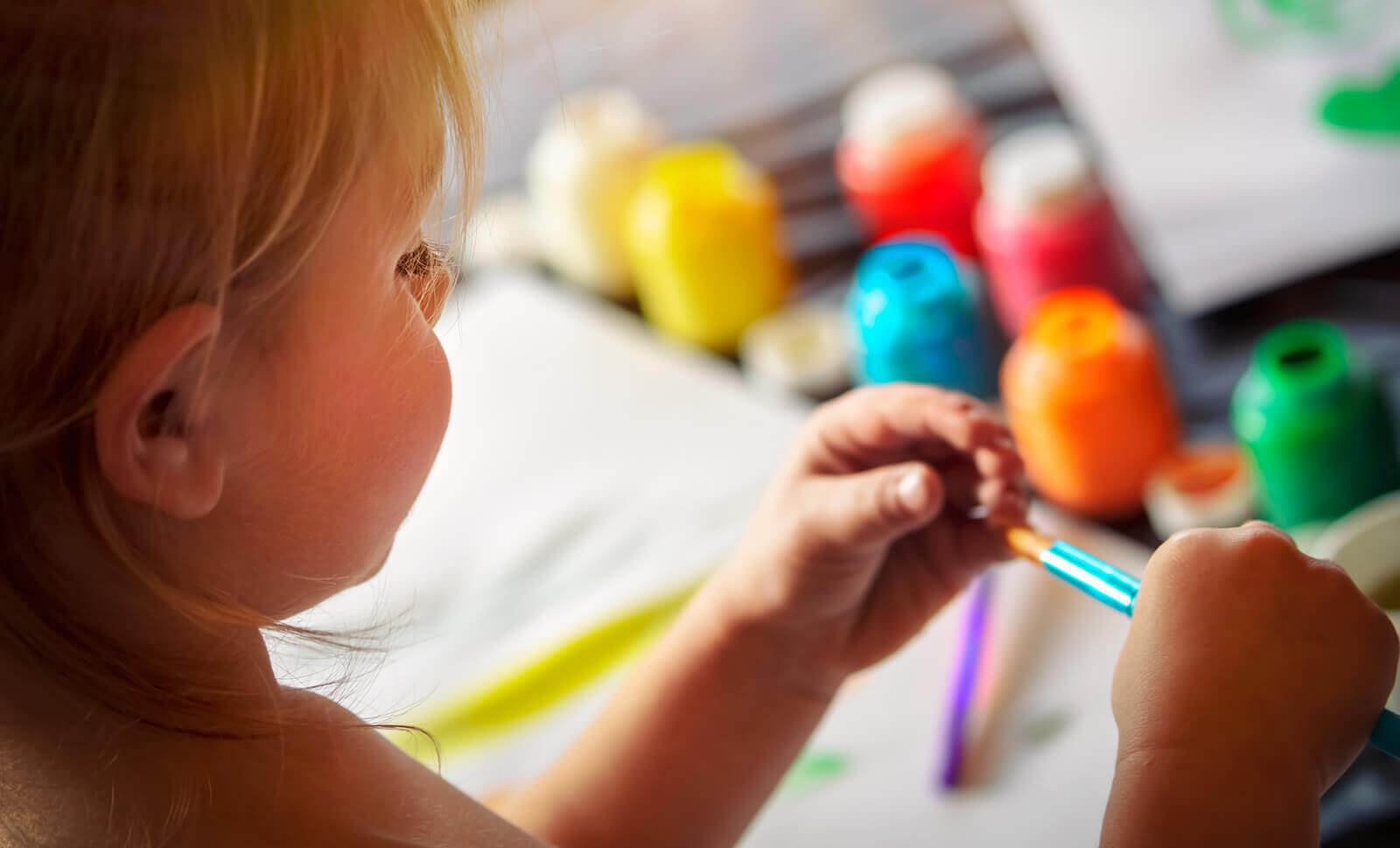The Evolution of Graphic Expression in Children


Written and verified by the pedagogue Marta Crespo Garcia
As children grow and change, so does their creative expression. Knowing the stages of the evolution of graphic expression in children allows you to identify the kind of drawings that characterize each age.
However, it’s not easy to say when one stage ends and another one begins. What’s more, as we all know very well, each child develops at their own rhythm, which we must respect.
What is graphic expression in children?
Graphic expression is an expressive language. It’s a means of representation and communication through the use of artistic materials and a variety of techniques that boost the creative process.
At the same time, graphic expression is a way to help children in their maturative, cognitive, and motor development. It also contributes positively to self-esteem, creativity, sensitivity, and perception.
Therefore, we should consider it a means, not an end. When it comes to the development of graphic expression, the idea is freedom of expression, not the creation of masterpieces.
All children draw what’s typical according to their age and stage of development. In the early years, their drawings are fairly predictable since they pertain to different stages. While they possess a typical graphism, as time goes by, each child will draw what represents them individually.

What does the evolution of graphic development in children indicate?
We should comprehend the different stages of graphic expression in children as an instrument for the orientation and knowledge of the educator and the family. That being said, we should never use it to make a final diagnosis or to label children.
In each stage, we can observe the projections that significantly impact children’s drawing. In other words, their drawings reveal what’s more important in their lives and how to experience it in their interior.
Therefore, we can consider drawing as a privileged path that helps us appreciate a child’s perspective. This helps us better understand them and adapt to their emotions in an understanding way.
But, in order to do so, we need to understand the general order of development. Once we understand the stages of graphic development in children, we can evaluate, understand, and investigate child development. This way, we can extrapolate the individual characteristics of each child.
The stages of graphic development in children
Various authors have studied the developmental stages of graphic development through drawing. Below, we’ll look at the ideas of Viktor Lowenfeld, who investigated the modifications that graphic expression undergoes in children as they mature physically, intellectually, and emotionally.
Scribbling (2-4 years, approximately)
During this stage, there’s no motivation to represent objects or people. Rather, the motivation lies in movement. Lowenfeld digs deeper in this stage by defining three different types of scribbles:
- Uncontrolled scribbling (18 months)
Around the age of 18 months, children begin to express themselves graphically by means of uncontrolled and meaningless scribbles. They lack motor control and don’t use their wrists or fingers in order to control movement.
In fact, it’s normal for them to not even pay attention to what they’re drawing. What’s important during this stage is motor activity. Therefore, there’s no intentionality and children enjoy the movement involved in scribbling.
- Controlled scribbling (2 years)
Little ones begin to control their movements and discover the relationship between movement and the lines on paper. This discovery causes them to carry out new experiences and movements in order to vary the results. Therefore, uncontrolled scribbling turns into a combination of curvy lines, sweeping strokes, and closed figures.
“Making something that wasn’t there before visible is an exciting experience.”
During this stage, children concentrate as they draw and even practice methods for holding their pen and paper. However, there’s still no intentionality. The only intentions are those of movement and the repetition of the schemes that they discover. Basically, little ones enjoy the movement and hand-eye coordination.
- The naming of scribbles (3 1/2 years)
The preschematic stage: Intentional representation (from 4 to 7 years)
Around the age of 4, children already control their strokes and begin to draw with more intention. They can draw mental representations of objects and figures, which adults can recognize. The human figure is the first that they achieve, by combining lines and circles.
When drawing the human figure, they place special importance on the head, which is proportionately larger than the rest of the body. The head consists of a circle that may contain greater or lesser detail. Little by little, their own perceptive experience will become richer.
The sizes of people, objects, etc. are disproportionate. What’s more, an objects’ size represents the importance it has for the child. Another characteristic of this stage is that people and things seem to be floating.
Here, the use of colors has an emotional significance since using them is an exciting experience. However, little ones have yet to use them with the intention of representing reality.
The schematic stage (7 to 9 years)
Drawings become much more defined and proportionate. Human figures now include all of their extremities and clearly defined details. Little by little, they begin to organize the space in their drawings. Therefore, they start to use lines to represent the ground and, later on, the sky. Likewise, there’s a logical relationship between objects and their environment.

Dawning realism (9 to 12 years)
Children try to enrich their drawings in order to make their representations more realistic. Therefore, they abandon geometric lines and begin drawing in three dimensions. The baseline disappears and spacial organization becomes more and more realistic.
Children begin to represent what characterizes them. It’s important to offer all sorts of materials and textures to children since exploring them will cause their creativity to flourish.
The pseudo-naturalistic stage (12 to 13 years)
During this stage, children place a much higher value on their artistic creations and begin to use spatial perspective. The human figure takes on well-defined sexual characteristics.
By this time, children have developed all of their motor and observational abilities. They can create works of art that rival those of adults, however, self-criticism and shame often hold them back.
The decision stage (from 13 to 14 years)
Children decide what technique to use and perfect. What they draw during this stage reveals their feelings (sensory impressionism). At this point, there’s a control of expression with a determined purpose.
Here, the difference between children’s drawings is well-defined. There are two types of creative subjects:
- The visual type observe attentively; contemplate things from the outside; consider first the whole and then the details; and prioritize appearance. This type is related to impressionism.
- The haptic type are especially emotional; project themselves in their drawings, expressing their sensory, kinesthetic, and tactile impressions. Haptic subjects prioritize the self. This type is related to expressionist painting.
Keep in mind
Keep in mind that the evolution of graphic expression in children has stages that occur in order and consecutively. All children go through these stages, though they don’t all go through them at the same age. Rather, the age ranges above are simply for orientation purposes.
What’s important is that little ones enjoy drawing and experimenting. Remember the free expression, and not creating masterpieces, is the foundation of the development of graphic expression.
As children grow and change, so does their creative expression. Knowing the stages of the evolution of graphic expression in children allows you to identify the kind of drawings that characterize each age.
However, it’s not easy to say when one stage ends and another one begins. What’s more, as we all know very well, each child develops at their own rhythm, which we must respect.
What is graphic expression in children?
Graphic expression is an expressive language. It’s a means of representation and communication through the use of artistic materials and a variety of techniques that boost the creative process.
At the same time, graphic expression is a way to help children in their maturative, cognitive, and motor development. It also contributes positively to self-esteem, creativity, sensitivity, and perception.
Therefore, we should consider it a means, not an end. When it comes to the development of graphic expression, the idea is freedom of expression, not the creation of masterpieces.
All children draw what’s typical according to their age and stage of development. In the early years, their drawings are fairly predictable since they pertain to different stages. While they possess a typical graphism, as time goes by, each child will draw what represents them individually.

What does the evolution of graphic development in children indicate?
We should comprehend the different stages of graphic expression in children as an instrument for the orientation and knowledge of the educator and the family. That being said, we should never use it to make a final diagnosis or to label children.
In each stage, we can observe the projections that significantly impact children’s drawing. In other words, their drawings reveal what’s more important in their lives and how to experience it in their interior.
Therefore, we can consider drawing as a privileged path that helps us appreciate a child’s perspective. This helps us better understand them and adapt to their emotions in an understanding way.
But, in order to do so, we need to understand the general order of development. Once we understand the stages of graphic development in children, we can evaluate, understand, and investigate child development. This way, we can extrapolate the individual characteristics of each child.
The stages of graphic development in children
Various authors have studied the developmental stages of graphic development through drawing. Below, we’ll look at the ideas of Viktor Lowenfeld, who investigated the modifications that graphic expression undergoes in children as they mature physically, intellectually, and emotionally.
Scribbling (2-4 years, approximately)
During this stage, there’s no motivation to represent objects or people. Rather, the motivation lies in movement. Lowenfeld digs deeper in this stage by defining three different types of scribbles:
- Uncontrolled scribbling (18 months)
Around the age of 18 months, children begin to express themselves graphically by means of uncontrolled and meaningless scribbles. They lack motor control and don’t use their wrists or fingers in order to control movement.
In fact, it’s normal for them to not even pay attention to what they’re drawing. What’s important during this stage is motor activity. Therefore, there’s no intentionality and children enjoy the movement involved in scribbling.
- Controlled scribbling (2 years)
Little ones begin to control their movements and discover the relationship between movement and the lines on paper. This discovery causes them to carry out new experiences and movements in order to vary the results. Therefore, uncontrolled scribbling turns into a combination of curvy lines, sweeping strokes, and closed figures.
“Making something that wasn’t there before visible is an exciting experience.”
During this stage, children concentrate as they draw and even practice methods for holding their pen and paper. However, there’s still no intentionality. The only intentions are those of movement and the repetition of the schemes that they discover. Basically, little ones enjoy the movement and hand-eye coordination.
- The naming of scribbles (3 1/2 years)
The preschematic stage: Intentional representation (from 4 to 7 years)
Around the age of 4, children already control their strokes and begin to draw with more intention. They can draw mental representations of objects and figures, which adults can recognize. The human figure is the first that they achieve, by combining lines and circles.
When drawing the human figure, they place special importance on the head, which is proportionately larger than the rest of the body. The head consists of a circle that may contain greater or lesser detail. Little by little, their own perceptive experience will become richer.
The sizes of people, objects, etc. are disproportionate. What’s more, an objects’ size represents the importance it has for the child. Another characteristic of this stage is that people and things seem to be floating.
Here, the use of colors has an emotional significance since using them is an exciting experience. However, little ones have yet to use them with the intention of representing reality.
The schematic stage (7 to 9 years)
Drawings become much more defined and proportionate. Human figures now include all of their extremities and clearly defined details. Little by little, they begin to organize the space in their drawings. Therefore, they start to use lines to represent the ground and, later on, the sky. Likewise, there’s a logical relationship between objects and their environment.

Dawning realism (9 to 12 years)
Children try to enrich their drawings in order to make their representations more realistic. Therefore, they abandon geometric lines and begin drawing in three dimensions. The baseline disappears and spacial organization becomes more and more realistic.
Children begin to represent what characterizes them. It’s important to offer all sorts of materials and textures to children since exploring them will cause their creativity to flourish.
The pseudo-naturalistic stage (12 to 13 years)
During this stage, children place a much higher value on their artistic creations and begin to use spatial perspective. The human figure takes on well-defined sexual characteristics.
By this time, children have developed all of their motor and observational abilities. They can create works of art that rival those of adults, however, self-criticism and shame often hold them back.
The decision stage (from 13 to 14 years)
Children decide what technique to use and perfect. What they draw during this stage reveals their feelings (sensory impressionism). At this point, there’s a control of expression with a determined purpose.
Here, the difference between children’s drawings is well-defined. There are two types of creative subjects:
- The visual type observe attentively; contemplate things from the outside; consider first the whole and then the details; and prioritize appearance. This type is related to impressionism.
- The haptic type are especially emotional; project themselves in their drawings, expressing their sensory, kinesthetic, and tactile impressions. Haptic subjects prioritize the self. This type is related to expressionist painting.
Keep in mind
Keep in mind that the evolution of graphic expression in children has stages that occur in order and consecutively. All children go through these stages, though they don’t all go through them at the same age. Rather, the age ranges above are simply for orientation purposes.
What’s important is that little ones enjoy drawing and experimenting. Remember the free expression, and not creating masterpieces, is the foundation of the development of graphic expression.
All cited sources were thoroughly reviewed by our team to ensure their quality, reliability, currency, and validity. The bibliography of this article was considered reliable and of academic or scientific accuracy.
- Federación de Enseñanza de CC.OO. de Andalucía. (2010). La expresión plástica en Educación Infantil. https://www.feandalucia.ccoo.es/docu/p5sd7610.pdf
This text is provided for informational purposes only and does not replace consultation with a professional. If in doubt, consult your specialist.








